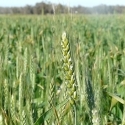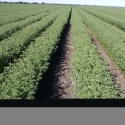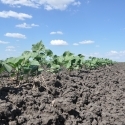07 Apr 2013
Grain Production in the Australian High Rainfall Zone
Starting from the soil up - nutrition will be the key
 Lime and gypsum piles ready for spreading.
Lime and gypsum piles ready for spreading.
The Australian high rainfall zone has seen a large expansion in cropping over the past 10 years due to the inclusion of innovations such as raised bed systems, improved herbicides, better adapted varieties and a decline in economic returns from livestock industries such as wool production and sheep and beef meats.
Figure 1. The Australian high rainfall zone.
Source: http://hrzwheats.com.au/content/high-rainfall-zone-australia
This zone is where average annual rainfalls are more than 550 mm, and is either coastal or on the western slopes of the Great Dividing Range. At present, there are around 2.7 Mha within this region with wheat yields around 2-3 t/ha. Zhang et al. (2006) estimated this region could expand to 4.6 Mha and with appropriate technology, yield potentials are 6-10 t/ha for wheat and 3-5 t/ha for canola.
Table 1. Regions within the Australian high rainfall zone, with current and potential crops areas and yields (Zhang et al. 2006).
| Region | Current Area Cropped (kha) | Potential Area Cropped (kha) | Current wheat yields (t/ha) | Potential wheat yields (t/ha) |
| Central West NSW | 748 | 821 | 2.9-3.5 | 6-8 |
| Riverine Plains | 652 | 842 | 2.9-3.4 | 6-8 |
| Central Vic | 142 | 261 | 2.3-2.6 | 6-8 |
| Southern Vic | 146 | 334 | 2.9-3.5 | 6-8 |
| Millicent Coast | 140 | 438 | 2.6 | 6-8 |
| Tasmania | 42 | 43 | 4.0 | 8-10 |
| SW WA | 864 | 1,118 | 2.7 | 5-6 |
| TOTAL | 2,736 | 4,603 |
N use could expand three fold to around 600kt of N, while P use could double. Current K use is low, but many of the soils into which cropping will expand show low soil K (top 10 cm) and around half the soils will need liming.
A recent paper by Nash et al. (2013) used a modelling approach within the Victorian high rainfall zone that identifies that a 4R Nutrient Stewardship approach can meet social, economic and environmental objectives. They found that additional N fertiliser can be applied after sowing to maximise gross margins, taking into account potential crop yield and seasonal conditions. Interestingly, the study suggests that where farmers increase their gross margins they are improving their environmental performance. This is counter intuitive as it implies N fertiliser applications can lessen N exports.
This results from the enhanced water uptake by the crop outweighing the adverse effects of increased N availability. It would appear that flexible cropping systems that maximise crop potential with minimum sowing N, maximise both economic and environmental performance.
The Australian high rainfall zone has become a focus area for future development, and IPNI will be working with industry, state and federal government agencies and grower groups to develop nutrient management programs that will meet the 4R Nutrient Stewardship principles.




